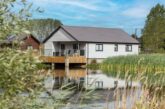
Kevin Taylor, Training and Technical Support Manager at Marley, outlines the main technical considerations to be aware of ahead of any solar PV installation project
For builders looking to capitalise on a new area of business building potential, the demand for solar PV installs is escalating. As the UK’s decarbonisation journey gathers pace – and new regulations promote the use of renewable energy solutions to deliver more energy efficient homes – this will intensify still further.
Government statistics from 2023 show that solar PV installations on UK roofs stand at over 1.35 million, with the period between 2022 and 2023 seeing the largest annual increase in installation for over seven years.
As the volume of consumer requests for solar PV systems soars, builders may well be faced with increasing questions from clients about a renewable energy system that can make a difference to energy cost pressures and underpin sustainable living. It’s therefore important that builders are clear about the main technical considerations ahead of any proposed install.

Is the roof suitable?
Before embarking on a solar PV install, the starting point should always be a careful assessment of the roof’s suitability. The sub-structure of both new and existing roofs should be checked to ensure the roof timbers are in good condition and have sufficient load bearing capacity. It is also important to check if the tops of the rafters are aligned, as poorly aligned rafters can lead bumpy battening, which can affect how well integrated system will sit on the roof. If rafters are poorly aligned, a degree of remedial work such as packing/notching battens or even replacing timbers may be necessary.
On retrofit contracts, it is also important to assess the condition of the battens, the underlay and the roof coverings, as there is little point in installing solar on a roof which might need replacing in a few years’ time.

Think structure
While solar panels will typically weigh less than roof tiles, weight distribution is still a key factor. Uneven distribution may require further structural evaluation to ensure potential weight issues are mitigated. All integrated solar will have a recommended minimum and maximum roof pitch, the minimum roof pitch refers the weatherproofing of the flashings, whilst the maximum pitch refers to the point at which the performance of the panels may no longer be commercially viable. Successful solar installs ideally require a roof pitch between 20° and 45°, with roofs outside these pitch parameters affecting the efficiency of the panels.
Finally, always consider safe working practices when on a solar install at height. Use scaffolding, be aware of the prevailing weather conditions and abide by PPE requirements and manual handling regulations to ensure both safe access and working conditions.
Pre-planning
It’s important to look at the solar panel layout and determine the number and orientation of the panels. They can be laid in either a landscape or portrait formation, depending on the roof size and shape. When it comes to orientation and angle considerations, a south-facing roof with a 35° angle is the optimal solution for maximising the energy from sun exposure and efficiency. And thinking about positioning should also always include looking at the impact of shading. Installs should avoid shading potential from nearby trees, chimneys or other adjacent buildings, as even partial shading can significantly reduce the overall efficiency of the solar panel system.
For existing properties where the new solar PV system is to be connected to the national grid, the installer of the panels will normally need to be a registered MCS installer, or at least be working in conjunction with one from the outset. This ensures the complete installation can be properly designed, signed off and commissioned. On new build properties, it is important that the relevant trades work effectively together and that all liabilities are agreed and understood before commencing work.
Cost and payback
Informed discussions with homeowners should always be the precursor to a project. Be aware of customer budget constraints and assess the number of panels that can be installed as a result. In addition, it’s advised that homeowners seek guidance on the expected payback period based on key factors, such as energy savings, thanks to the renewable energy source and the rates at which energy can be sold back to the grid.
For more information, visit Marley’s website at Pitched Roof Tile Specialists | Marley.







